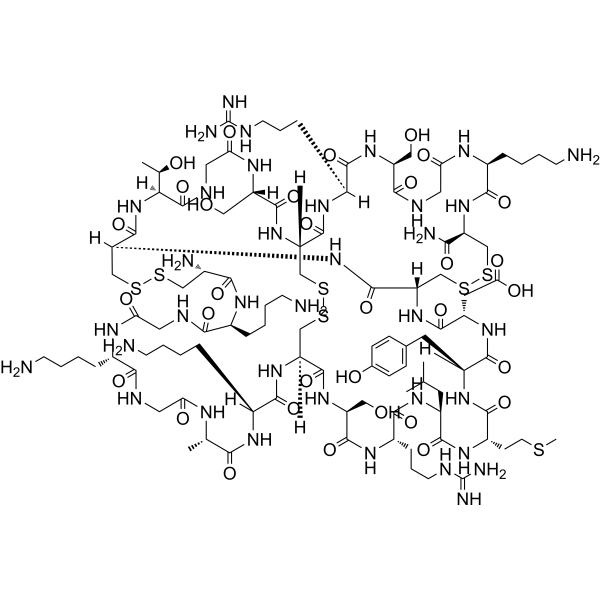
Ziconotide
CAS No. 107452-89-1
Ziconotide( —— )
Catalog No. M30258 CAS No. 107452-89-1
Ziconotide is an atypical analgesic agent for the amelioration of severe and chronic pain. Derived from Conus magus, a cone snail, it is the synthetic form of an ω-conotoxin peptide.
Purity : >98% (HPLC)
 COA
COA
 Datasheet
Datasheet
 HNMR
HNMR
 HPLC
HPLC
 MSDS
MSDS
 Handing Instructions
Handing Instructions
| Size | Price / USD | Stock | Quantity |
| 100MG | Get Quote | Get Quote |


|
| 200MG | Get Quote | Get Quote |


|
| 500MG | Get Quote | Get Quote |


|
Biological Information
-
Product NameZiconotide
-
NoteResearch use only, not for human use.
-
Brief DescriptionZiconotide is an atypical analgesic agent for the amelioration of severe and chronic pain. Derived from Conus magus, a cone snail, it is the synthetic form of an ω-conotoxin peptide.
-
DescriptionZiconotide is an atypical analgesic agent for the amelioration of severe and chronic pain. Derived from Conus magus, a cone snail, it is the synthetic form of an ω-conotoxin peptide.
-
In VitroMost native cells express a variety of different calcium channels and as a result, Ziconotide only partially reduces high-voltage-activated calcium currents in differentiated human neuroblastoma IMR32 cells, rat superior cervical ganglion neurons, and rat hippocampal neurons. Ziconotide also reduces calcium currents that result from expression of the α1B subunit in HEK cells, tsa-201 cells, and Xenopus laevis oocytes.Ziconotide delivers its antinociceptive efficacy by reducing the release of pronociceptive neurotransmitters in the dorsal horn of the spinal cord, thereby inhibiting pain signal transmission.
-
In VivoZiconotide (i.t.; 25-100 pmol/site; 5 μL; on the 4 th, 10 th, 15 th, 20 th, and 24 th days) reduces the levels of IL-1β and IL-23 in the CNS, as well as IL-17 production in the spleen, 25 days after MOG35-55-elicited EAE, in the mouse model of experimental autoimmune encephalomyelitis (EAE). Animal Model:Female C57BL/6mice (18-22 g, 6-8 weeks old) injected with myelin oligodendrocytes glycoprotein Dosage:25 pmol/site, 50 pmol/site, 100 pmol/site Administration:Intrathecal injection; on the 4 th, 10 th, 15 th, 20 th, and 24 th days Result:Significantly reduced the mechanical hypersensitivity in animals with EAE.
-
Synonyms——
-
PathwayGPCR/G Protein
-
TargetCalcium Channel
-
Recptor——
-
Research Area——
-
Indication——
Chemical Information
-
CAS Number107452-89-1
-
Formula Weight2639.13
-
Molecular FormulaC102H172N36O32S7
-
Purity>98% (HPLC)
-
Solubility——
-
SMILES——
-
Chemical NameSequence:{Cys}{Lys}{Gly}{Lys}{Gly}{Ala}{Lys}{Cys}{Ser}{Arg}{Leu}{Met}{Tyr}{Asp}{Cys}{Cys}{Thr}{Gly}{Ser}{Cys}{Arg}{Ser}{Gly}{Lys}{Cys}-NH2(Disulfide bridge: Cys1-Cys16; Cys8-Cys20; Cys15-Cys25)
Shipping & Storage Information
-
Storage(-20℃)
-
ShippingWith Ice Pack
-
Stability≥ 2 years
Reference
Brinzeu A, et al. Ziconotide for spinal cord injury-related pain. Eur J Pain. 2019 Oct;23(9):1688-1700.
molnova catalog



related products
-
Imagabalin
Imagabalin (PD 0332334) is a novel ligand for the α2δ subunit of the voltage-dependent calcium channel (VDCC) with some selectivity for the α2δ1 subunit over α2δ2.
-
PD173212
PD 173212 is a blocker that blocks N-type voltage sensitive calcium channel (Cav2.2). PD173212 (0.0017-1.7 μmol/kg, Intraperitoneal Injection.) dose-dependently reduced DNBS-induced visceral hypersensitivity in mice.
-
HUP30
HUP30 is a potent vasodilating agent. HUP30 can stimulate soluble guanylyl cyclase, activate K+ channels, and block extracellular Ca2+ influx.



 Cart
Cart
 sales@molnova.com
sales@molnova.com


